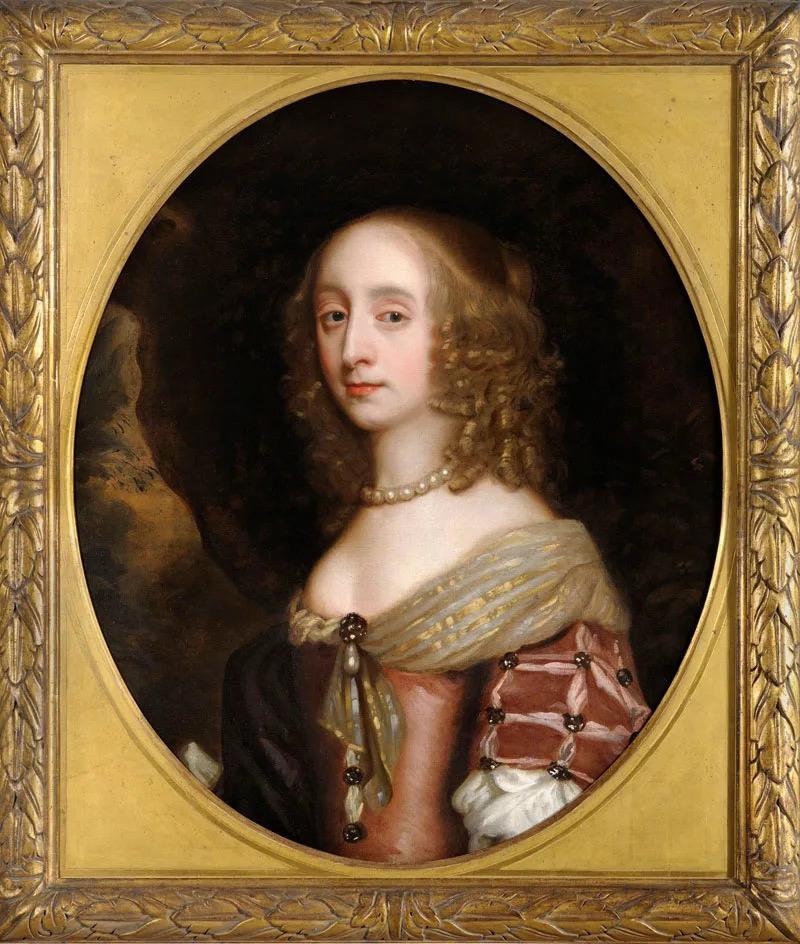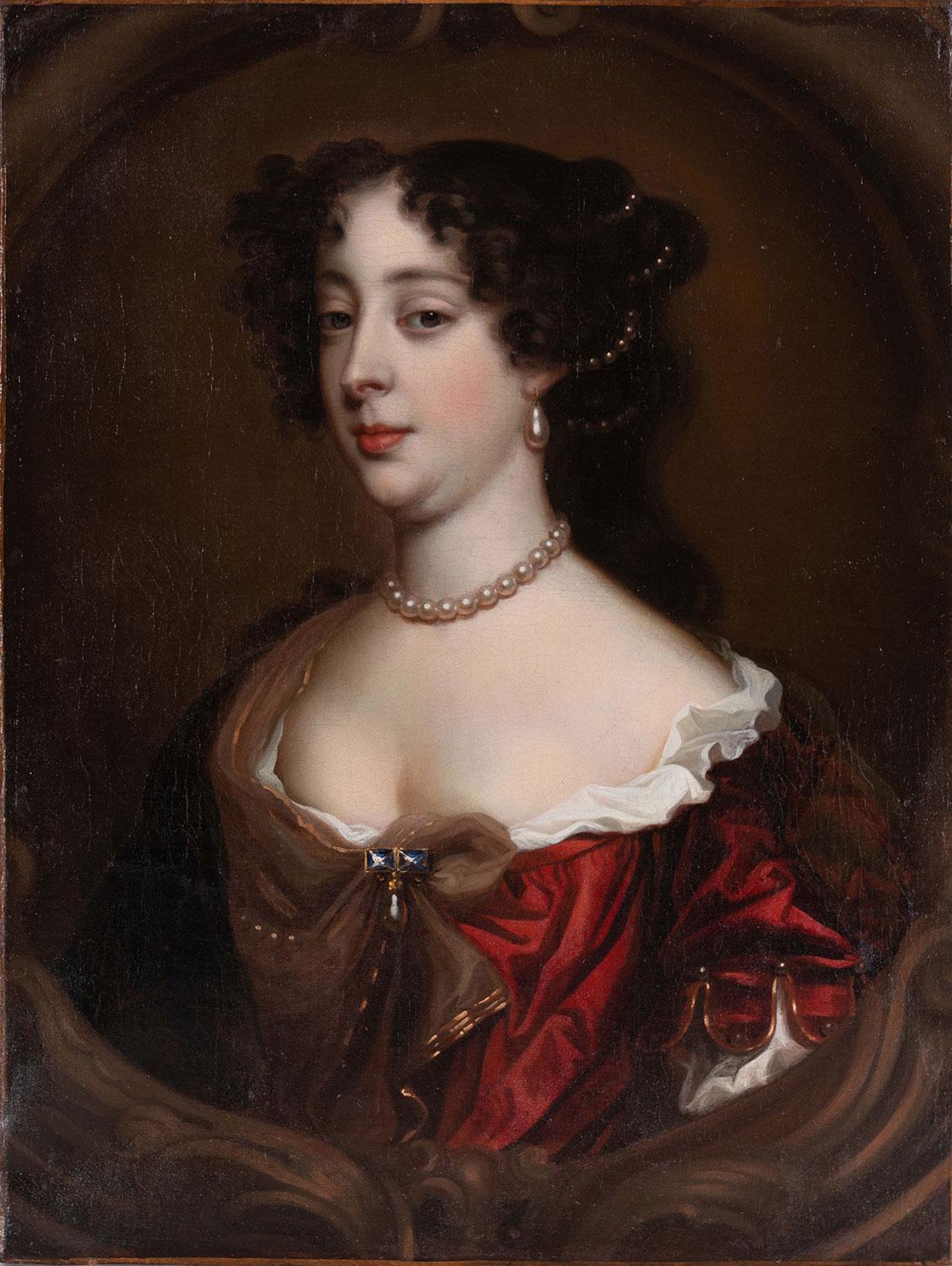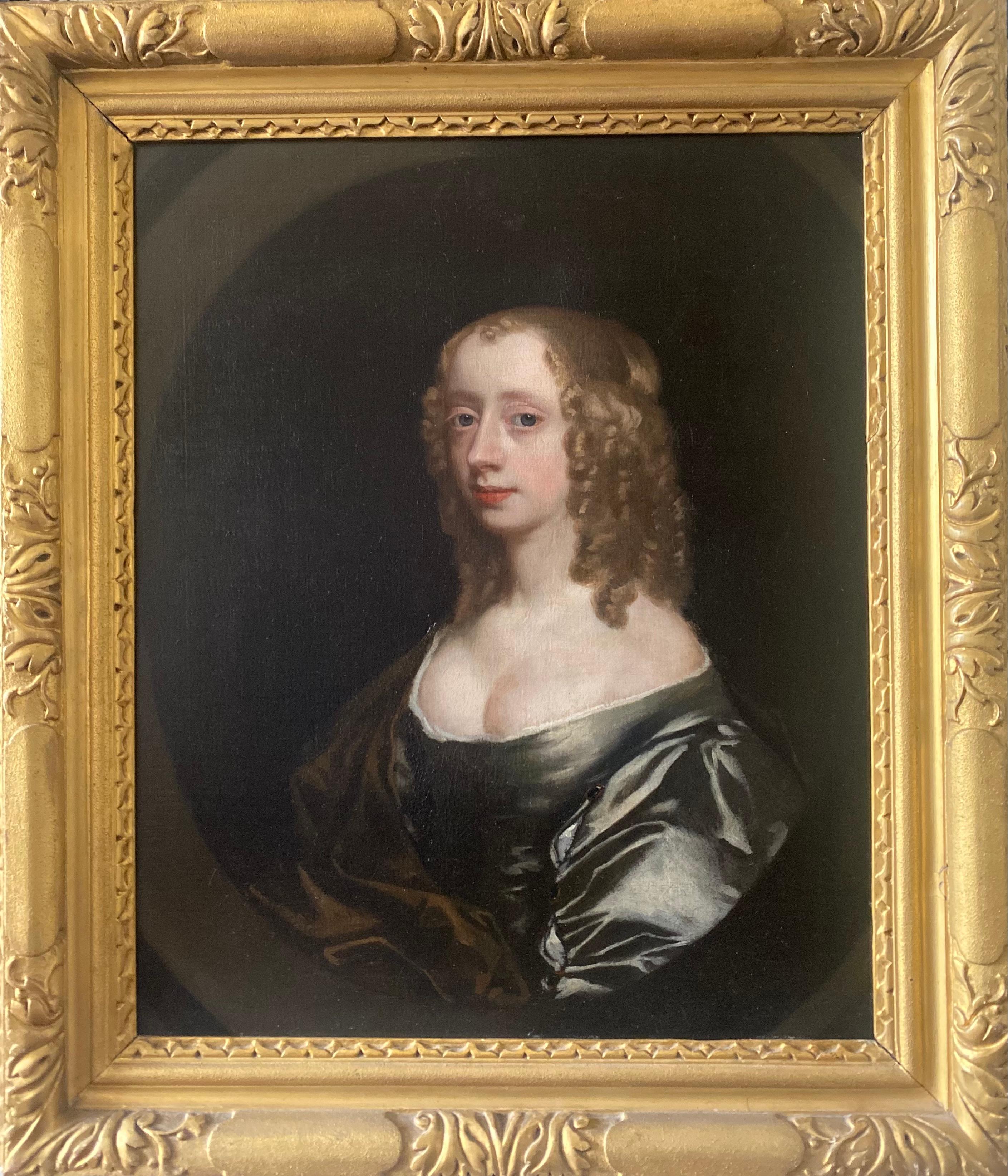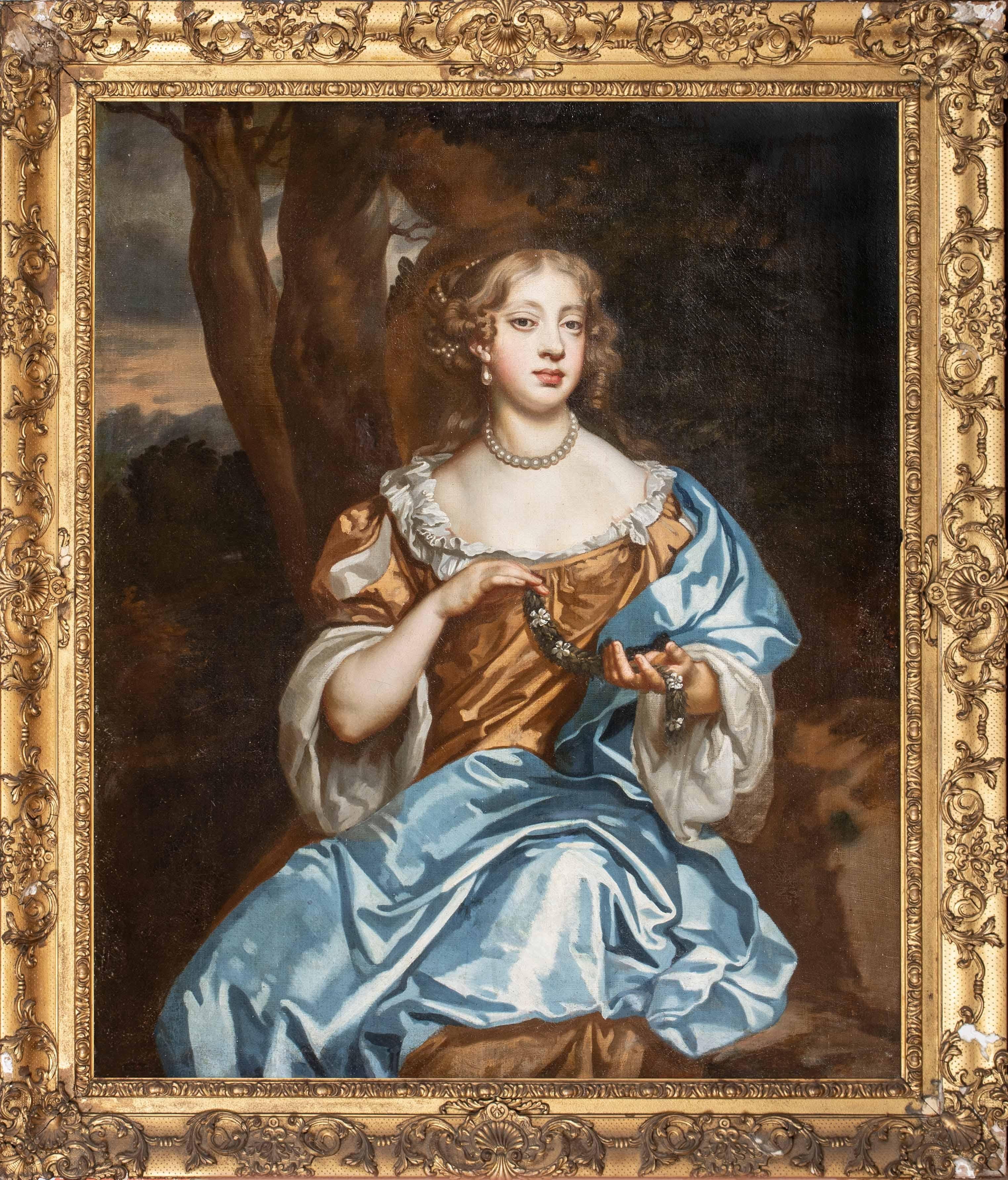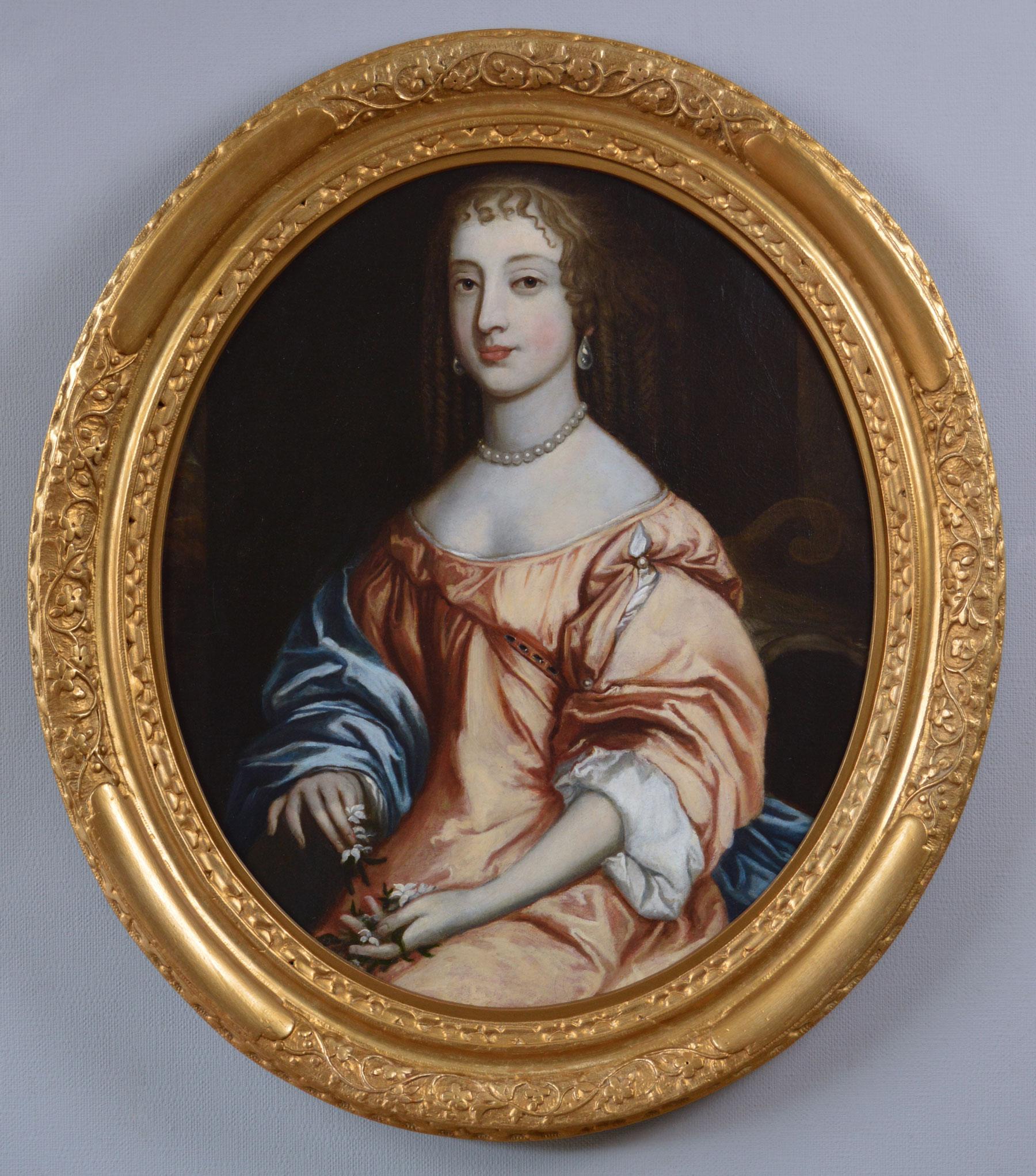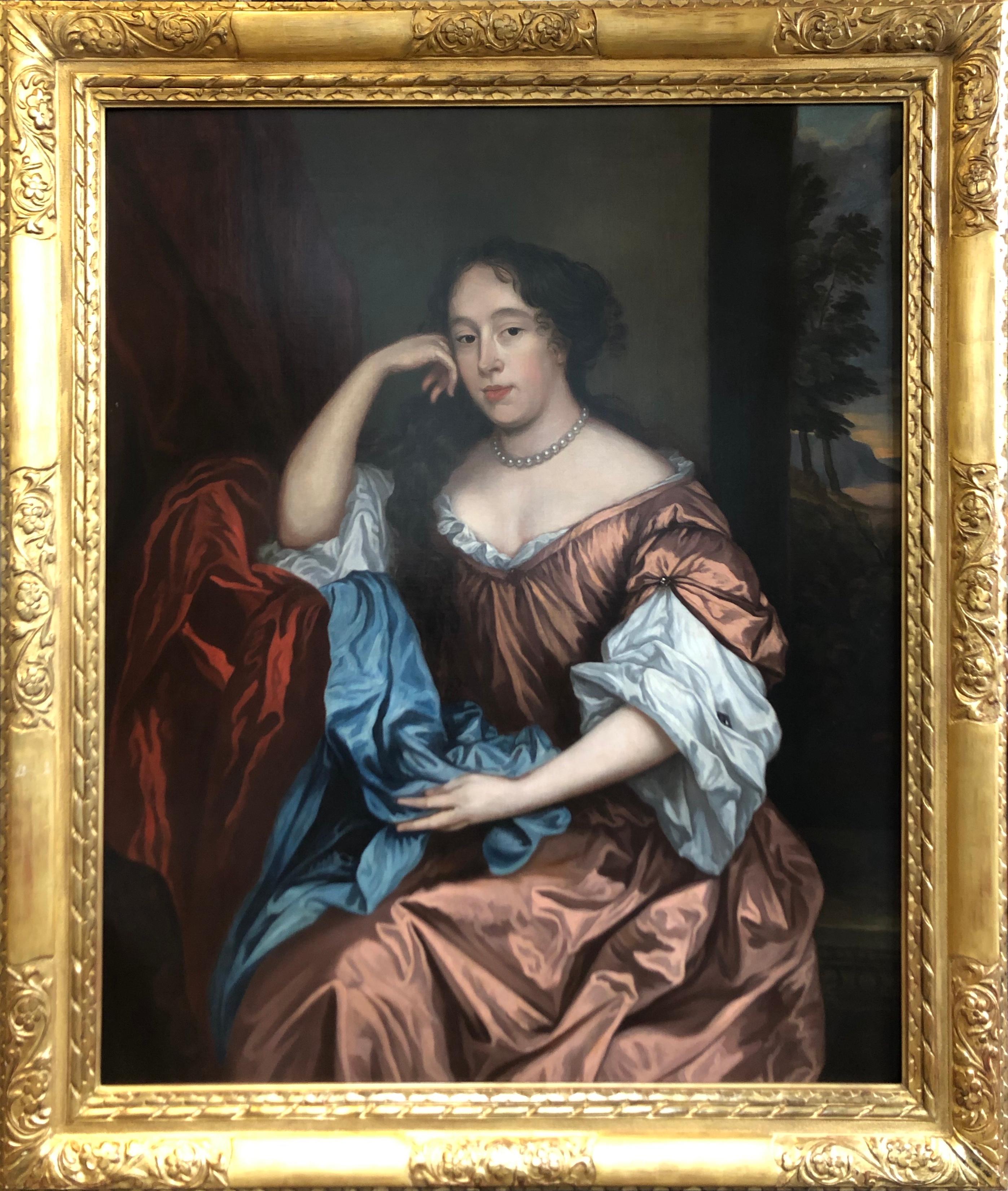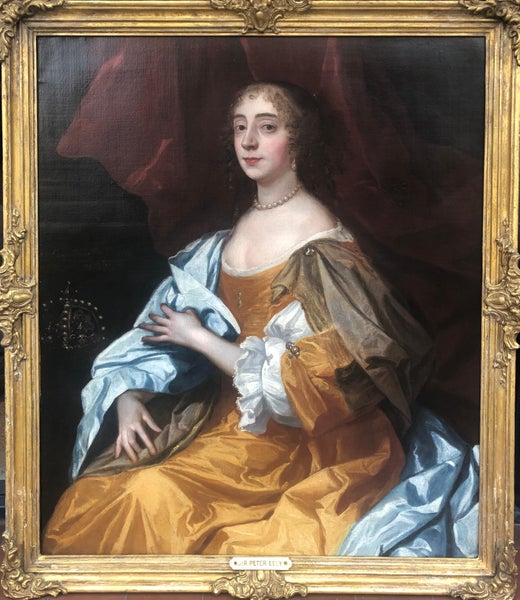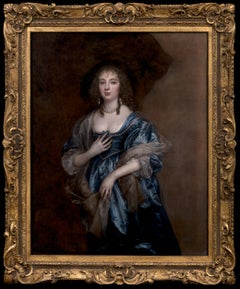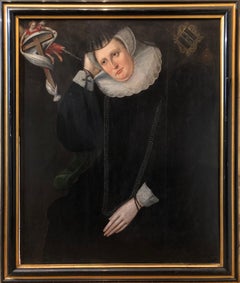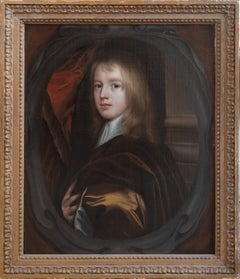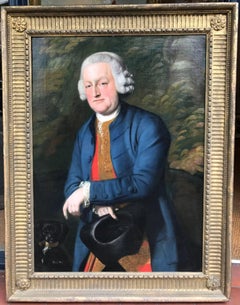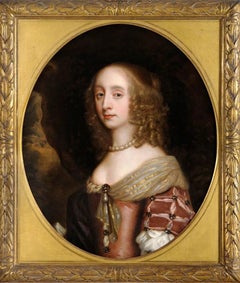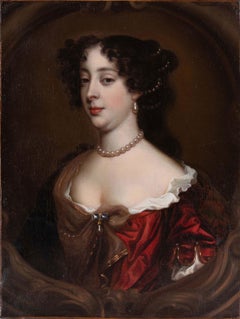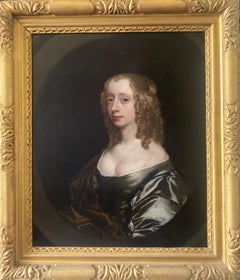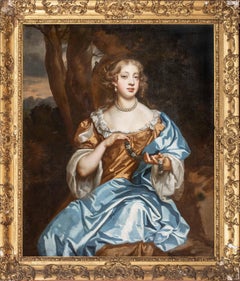Items Similar to Portrait of Bridget Drury Lady Shaw, formerly Viscountess Kilmorey
Want more images or videos?
Request additional images or videos from the seller
1 of 7
Sir Peter LelyPortrait of Bridget Drury Lady Shaw, formerly Viscountess Kilmorey1665
1665
$71,471.40
$89,339.2520% Off
£52,000
£65,00020% Off
€60,849.68
€76,062.1020% Off
CA$98,491.17
CA$123,113.9620% Off
A$108,385.81
A$135,482.2620% Off
CHF 56,837.63
CHF 71,047.0420% Off
MX$1,315,402.58
MX$1,644,253.2220% Off
NOK 710,461.48
NOK 888,076.8520% Off
SEK 672,610.22
SEK 840,762.7820% Off
DKK 454,179.32
DKK 567,724.1520% Off
About the Item
Sir Peter Lely (Soest 1618 – 1680 London)
Portrait of lady with a crown, possibly Bridget Drury Lady Shaw, formerly Viscountess Kilmorey, later Lady Baber (d.1696) c.1665
Oil on canvas
46 1/2 x 40 3/4 inches, Framed
42 1/4 x 36 1/4 inches, Unframed
Inscribed left [……….]Isabella
James Mulraine wrote the following for this piece:
This portrait dates to the middle of the 1660s, the decade when Lely’s career took off as successor to Sir Anthony van Dyck. At the Restoration Charles II had appointed him Principal Painter to the King and paid a pension £200 per annum ‘as formerly to Sr. Vandyke...’1 Lely had trained in Haarlem and he was in his early twenties when he came to London in 1643. He was an astute businessman and a wise courtier. In 1650 he painted a portrait of Oliver Cromwell (Birmingham Museum and Art Gallery) while maintaining links with the Royalist exiles through the 1650s. He had arrived in England as a painter of small-scale portraits and lush scenes of nymphs in landscapes in a Dutch style. His experience of Van Dyck in English collections transformed his painting. His lavish and alluring vision of Arcadia exactly captured the spirit of the Court and as Principal Painter he dominated English portraiture for the next twenty years. Lely ran a highly efficient studio along Netherlandish lines, employing a team of specialists like the drapery painter John Baptist Gaspars and young artists-in-training like Nicolas de Largilliere. He had numerous rivals during that period, and by 1670 he had introduced numbered standard poses to speed up production, while collaborating with printmakers for further revenue and advertising. He died in 1680 of a stroke while painting, working to the last.
The portrait, painted at a date when Lely’s poses and execution were still individual and inventive shows a lady sitting at three-quarter length facing away from the viewer. She has begun to turn towards the viewer, a pose with a long pedigree in art, first used by Leonardo da Vinci in the Mona Lisa (Louvre). She steadies her blue drapery where it might slip from her arm with the movement, a flash of realism beautifully captured. Like Van Dyck, Lely painted his female sitters in a timeless costume rather than contemporary fashion, showing a loose gown and floating silk draperies. It presented the sitter as a classical ideal. The portrait would not date.
The saffron dress may be the work of a drapery painter but the brown scarf must be by Lely himself, and appears unfinished, broadly sketched in behind the shoulder. The delicate blue glaze and nervous highlights suggest shimmering translucence. Lely was a master of painting hands – his hand studies are marvels of drawing – and the lady’s hands are superb, exactly drawn, delicately modelled and expressive. The fidgety gestures, clutching the gown, fiddling with the edge of the scarf, give the portrait psychological bite, suggesting the personality behind the calm courtier’s expression, adding to the sense shown in the look of the eyes and mouth that the lady is about to speak. The portrait’s language is Vandykian. The inspiration comes directly from Van Dyck’s English portraits of women. Lely owned Van Dyck’s Portrait of Lady Elizabeth Thimbleby and Dorothy Viscountess Andover (National Gallery, London) and the sitter’s costume quotes Lady Andover’s saffron dress and brown scarf. But Lely paints a generation who sat nearer to the ground and through a dialogue of expression and gesture he shows sitters who are more flesh and blood than Van Dyck’s.
The background with a column and curtain is different to those shown in most of Lely’s portraits of women. They tend to include trees or fountains, with a glimpse of landscape. But there are other examples. A portrait of the King’s reigning mistress, Barbara Villiers Duchess of Cleveland c.1664-5 (Lydiard Park, Swindon Museum and Art Gallery) shows her sitting in front a stone wall and column with a curtain to the left. Elizabeth Hamilton Countess of Gramont c.1663 (Royal Collection) is shown as St Catherine against a plain dark background between a column and a curtain, perhaps as a tribute to Queen Catherine of Braganza. Catherine herself was painted by Lely with a stone and curtain background (engraving by Abraham Blooteling after Lely, c.1678, British Museum). It is a commanding, regal formula.
Our portrait is also regal, very much more so, because a royal crown is shown resting on a ledge below the column, painted with autograph virtuosity in details such as the highlights on the pearls. It is a queen’s crown. The details compare broadly with Catherine of Braganza’s crown shown in Blooteling’s engraving. Comparison of dates – our sitter looks to be in her late 30s in the early/mid 1660s – and likeness found no matches with crowned heads at this date. There is an old two-line inscription painted on the plinth of the column above the crown, overscored and illegible except the final word Isabella. Isabella de Bourbon Queen of Spain (1602 – 1644) was Queen Henrietta Maria’s sister. Portraits in country house collections are sometimes misidentified by later generations. If the inscription was painted on in the Eighteenth Century the identity of a woman with a crown could have been mistaken. But the sitter’s fidgety gesture, and informal dress would be highly unusual in a royal portrait, certainly in one formal enough to include the crown, just as the crown would be an extraordinary addition to a portrait of a non-royal sitter.
One portrait does show a commoner with a Royal Crown, the portrait of Jane Lane Lady Fisher by an unknown artist c.1660 (National Portrait Gallery), shows her holding up the Crown, protecting and venerating it. Jane Lane’s portrait commemorates her role in helping King Charles II escape after the Battle of Worcester, when he travelled in disguise as her servant. Comparing our lady with Lely portraits of this date there is one sitter with a striking resemblance. Lely’s portrait of Bridget Drury Viscountess Kilmorey shows a woman who looks remarkably similar to our sitter (Sotheby’s 13th November 1991 lot 24; ex-collection Earls of Kilmorey).
Bridget Drury (probably born c.1620/25) was the daughter and co-heir of Sir William Drury of Beesthorpe, Norfolk and his wife Mary daughter of William Cokayne, merchant of London. She married Charles Needham younger son of the 2nd Viscount Kilmorey in 1655. Needham succeeded his brother as 4th Viscount Kilmorey in 1657. In August 1659 Lord Kilmorey was one of the commanders of Booth’s Uprising, an unsuccessful Royalist rebellion in Cheshire in August 1659. He was defeated near Chester and imprisoned in London where he died the following year, only months before King Charles II was invited back to England in May. Lady Drury remarried in 1663. Her second husband was Sir John Shaw. Shaw had been merchant in Antwerp during the Civil War and Interregnum. He provided money for King Charles I’s armies and was later a key source of money and information to the King and Court in exile. The Earl of Clarendon ‘wrote at one time that without Shaw the King could not have got bread.’2 At the Restoration Shaw was knighted. He was elected MP for Lyme Regis in 166 and sat until 1678. He was also appointed to a string of lucrative posts including Farmer of the Customs. After his marriage to the widowed Lady Kilmorey the King created him a baronet. At the same date Shaw bought a lease of a royal property, the King’s House at Eltham for £3,700, which he had rebuilt by the Court architect Hugh May as Eltham Lodge. In 1668 ‘Lady Bridget Shaw’ is recorded as a co-defendant with Shaw, Sir Henry Vernon Bt, Sir Peter Leycester Bt and Sir John Booth in an action brought against her son Thomas 6th Viscount Kilmorey.3
Bridget Lady Shaw continued to live at Eltham after her husband’s death in 1680. In 1681 she married Sir John Baber MD (1625 – 1704). Baber had been appointed King Charles II’s doctor and knighted at the Restoration, and being a presbyterian, was used by the King as a go-between in negotiations with religious dissenters. Bridget Lady Baber died at Eltham in July 1696.
At present Bridget Drury’s biography exists only as a wife to her husbands, and as mother to her sons Robert and Thomas, the 5th and 6th Viscounts Kilmorey. The Sotheby’s portrait of Bridget Viscountess Kilmorey raises intriguing questions. The sitter looks dreamily towards the viewer, leaning her head on her right arm, with her elbow resting on a red velvet-draped table. On the table a luscious display of ripe glistening fruits, pendant plums and plump peaches. The sitter’s other arms rests across her lap like an echo of the Medici Venus. Noticeably her bodice is low-cut enough to expose her breast and show her nipple. This detail invariably indicates a portrait of a mistress4, like Lely’s portrait of Diana Kirke Countess of Oxford c.1665-70 (Yale Center for British Art, Paul Mellon Collection) or his lost portrait of Nell Gwynn c.1673 (engraved Peter Valck, National Portrait Gallery).
A version of the Sotheby’s painting was sold at Christie’s 15th June 2001 lot 6 as an unidentified woman. The Christie’s painting was formerly at Crewe Hall near Nantwich in Cheshire, where she was traditionally called Barbara Villiers. This identification was plainly wrong, but it is a handy example, both of the rule that the format indicated a portrait of a mistress, and of the way that portraits in country house collections can be misidentified over time. The provenance is significant. The Kilmorey family were originally from Shropshire, but Bridget’s mother-in-law Eleanor Dutton (d.1665) was a Cheshire heiress. The 2nd Viscount Kilmorey based the family at his wife’s family’s estate at Dutton, and clearly had great interests in the county. The co-defendants in the 1668 case are Cheshire gentry, including a member of the Booth family. The Cheshire provenance of the Christie’s painting certainly supports an identification with Bridget Viscountess Kilmorey. If both portrait types - the regal image with a crown, and the erotically charged paintings from the Kilmorey and Crewe collections – do indeed show Bridget Drury they add a remarkable dimension to a life that is otherwise relatively obscure, and like all women’s lives in this period deserves to be better known.
of Broad Street, Lo
1. Catherine Macleod ‘Good but not like’: Peter Lely, portrait practice and the creation of a Court Look in Catherine Macleod, Julia Marciari Alexander, Kevin Sharpe, Diana Dethloff, Sonya Wynne and David Taylor ‘Painted Ladies Women at the Court of Charles II’ National Portrait Gallery London and Yale Center for British Art, New Haven, p.51
2. ‘Sir John Shaw (c.1615 – 80) of London and Eltham Lodge, Kent in The History of Parliament: the House of Commons 1660-1690, ed. B.D. Henning, 1983
3. Mary Rush, widow v Thomas Viscount Kilmorey and others. 1668, National Archives, Kew C 9/40/72
4. Macleod, Alexander et al. 2001, p.100
- Creator:Sir Peter Lely (1618 - 1680, Dutch)
- Creation Year:1665
- Dimensions:Height: 46.5 in (118.11 cm)Width: 40.75 in (103.51 cm)
- Medium:
- Period:1660-1669
- Condition:
- Gallery Location:London, GB
- Reference Number:1stDibs: LU67336975732
Sir Peter Lely
Sir Peter Lely (1618-1680) was born in Germany at Soest in Westphalia in 1618. Though his family name was van der Faes, he assumed the name Lely after the lily that was carved on the gable of his father’s home in The Hague. He moved to England in 1641, the year that Van Dyck died, and succeeded Van Dyck. He was court painter to Kind Charles I and King Charles II. By working for many of the patrons of the late van Dyck, Lely rapidly established himself as one of the country’s most important portrait painters.
About the Seller
5.0
Vetted Professional Seller
Every seller passes strict standards for authenticity and reliability
Established in 1990
1stDibs seller since 2017
42 sales on 1stDibs
Typical response time: Several days
- ShippingRetrieving quote...Shipping from: London, United Kingdom
- Return Policy
Authenticity Guarantee
In the unlikely event there’s an issue with an item’s authenticity, contact us within 1 year for a full refund. DetailsMoney-Back Guarantee
If your item is not as described, is damaged in transit, or does not arrive, contact us within 7 days for a full refund. Details24-Hour Cancellation
You have a 24-hour grace period in which to reconsider your purchase, with no questions asked.Vetted Professional Sellers
Our world-class sellers must adhere to strict standards for service and quality, maintaining the integrity of our listings.Price-Match Guarantee
If you find that a seller listed the same item for a lower price elsewhere, we’ll match it.Trusted Global Delivery
Our best-in-class carrier network provides specialized shipping options worldwide, including custom delivery.More From This Seller
View AllPortrait of Anne, Lady Russell, later Countess of Bedford
By Anthony van Dyck
Located in London, GB
A three-quarter length portrait of Anne, Lady Russell, later Countess of Bedford (1615-1684), in a blue dress. Attributed to Sir Anthony Van Dyck.
Anne C...
Category
17th Century Portrait Paintings
Materials
Oil
$208,916 Sale Price
24% Off
Lady Dormore - A 16th Century Portrait of a key member of Shakespeare's England
Located in London, GB
Lady Dormer, Mary Browne
c. 1592
oil on panel
35 x 29 inches, unframed;
41 x 34.75 inches, inc. frame
Inscribed 'Lady Dormore'
Mary married Henry Wriothesley, 2nd Earl of Southampton who gave birth to Henry Wriothesley, 3rd Earl of Southampton - one of the great figures in Shakespears"s circle and founder of the Virginia company, developers of Virginia USA.
Henry Wriothesley, born 6 October 1573 at Cowdray House, Sussex, was the only son of Henry Wriothesley, 2nd Earl of Southampton, by Mary Browne, the only daughter of Anthony Browne, 1st Viscount Montague, and his first wife, Jane Radcliffe.[5] He had two sisters, Jane, who died before 1573, and Mary (c. 1567 – 1607), who in June 1585 married Thomas Arundell, 1st Baron Arundell of Wardour.[6]
After his father's death, Southampton's mother married firstly, on 2 May 1595, as his second wife, Sir Thomas Heneage (d. 17 October 1595), Vice-Chamberlain of the Household, and secondly, between 5 November 1598 and 31 January 1599, Sir William Hervey. She died in November 1607.[7]
Early life
When his father died on 4 October 1581 Southampton inherited the earldom and landed income valued at £1097 6s per annum. His wardship and marriage were sold by the Queen to her kinsman, Charles, Lord Howard of Effingham, for £1000. According to Akrigg, Howard then "entered into some further agreement, of which no documentation can now be found, which transferred to Lord Burghley personally the custody and marriage of the young Earl, but left Howard holding his lands", and late in 1581 or early in 1582 Southampton, then eight years of age, came to live at Cecil House in the Strand.[8]
In October 1585, at age twelve, Southampton entered St John's College, Cambridge,[9] graduating M.A. on 6 June 1589.[10] His name was entered at the Gray's Inn legal society before he left the university, and he was admitted on 29 February 1588.[11]
On Southampton's 16th birthday, 6 October 1589, Lord Burghley noted Southampton's age in his diary, and by 1590 Burghley was negotiating with Southampton's grandfather, Anthony Browne, 1st Viscount Montague, and Southampton's mother, Mary, for a marriage between Southampton and Lord Burghley's eldest granddaughter, Elizabeth Vere, daughter of Burghley's daughter, Anne Cecil, and Edward de Vere...
Category
16th Century Old Masters Figurative Paintings
Materials
Oil
17th Century Oil Painting Portrait of a Young English Boy
By Gerard Soest
Located in London, GB
Gerard SOEST (1600 - 1681)
Portrait of a Young Boy
oil on canvas
35.5 x 30.5 inches inc. frame
Gerard Soest (circa 1600 – 11 February 1681), also known as Gerald Soest, was a portra...
Category
17th Century Old Masters Portrait Paintings
Materials
Oil
18th Century Oil Painting Portrait of Phillip, 6th Viscount Wenman.
By Nathaniel Dance-Holland
Located in London, GB
Sir Nathaniel Dance-Holland (1750-1811) was an English portrait painter and one of the founding members of the Royal Academy in 1768. Justly celebrated in his lifetime he won several...
Category
Late 18th Century Old Masters Portrait Paintings
Materials
Oil
Double Portrait Oil Painting Brothers George, 2nd Duke Buckingham & Lord Francis
By (After) Anthony Van Dyck
Located in London, GB
Aftrer Anthony VAN DYCK - maybe Studio (1599, Antwerp – 1641, London) Flemish
Double Portrait of George Villiers, 2nd Duke of Buckingham (1628-1687) & Lord Francis Villiers (1629-1648)
Oil on Canvas
170 x 147 cm
Anthony Van Dyck (1599-1641)
No painter has done more to define an era than Anthony van Dyck. He spent only seven and a half years of his short life (1599- 1641) in England. He grew up in Antwerp, where his precocious talent was recognised by Peter Paul Rubens, the greatest painter of his age. He worked in Rubens’s studio and imitated his style as a religious artist, painting biblical scenes redolent of the lush piety of the counter-reformation. But soon he was on the move. In 1620, he visited London for a few months, long enough to paint a history picture, The Continence of Scipio, for the royal favourite, George Villiers, Marquess of Buckingham, and a portrait of his other English patron, the great art collector, Thomas Howard, 2nd Earl of Arundel.
After a stint in Italy, making imposing portraits of the wealthy aristocracy and sketching and copying works by Titian, he returned to the Spanish Netherlands in 1627, becoming court artist to Archduchess Isabella before departing for The Hague in 1631 to paint the Dutch ruler Frederick Henry, Prince of Orange. Charles I’s invitation in 1632 led Van Dyck back to London where he was knighted, paid an annual salary of £200 and installed in a house in Blackfriars with a special jetty at which the royal barge might tie up when the King was visiting his studio. By this time Van Dyck was recognised as the leading court painter in Europe, with Velazquez at the court of Philip IV of Spain his only rival. He also excelled as a superbly observant painter of children and dogs.
Van Dyck’s notoriety in depicting children led to the introduction of groups of children without their parents as a new genre into English painting (amongst other new genres).
For the next 300 years, Van Dyck was the major influence on English portraiture. Nearly all the great 18th Century portraitists, from Pompeo Batoni and Allan Ramsay to Thomas Gainsborough and Joshua Reynolds, copied Van Dyck’s costumes, poses and compositions.
George Duke of Buckingham & his brother Francis Villiers
Painted in 1635, this double portrait was originally commissioned by Charles I, who raised the two brothers after their father, George Villiers, was assassinated in 1628. Together with their sister, Lady Mary Villiers, they enjoyed the King’s favour absolutely. Francis whose absolute ‘inimitable handsomeness’ was noted by Marvell (who was killed in a skirmish near Kingston upon Thames). The young duke who commanded a regiment of horse at the Battle of Worcester, remained closely associated with Charles II, held a number of high offices after the Restoration and was one of the most cynical and brilliant members of the King’s entourage, immortalised as ‘Zimri’ in Dryden’s Absalom and Achitopbel. As a young man he had sold his father’s great collection of pictures in the Spanish Netherlands, many of them to the Archduke Leopold Willhelm.
Painted for Charles I and placed near the portrait of their sister in the Gallery at St James’ Palace. The handling of both costumes is very rich, and the heads are very carefully and sensitively worked. That of the younger boy in particular is more solidly built up than the lower part of the figure. A preparatory drawing for the younger boy is in the British Museum.
There are copies at, e.g., Highclere Castle...
Category
17th Century Old Masters Portrait Paintings
Materials
Oil
C19th Portrait Princesse de Joinville of Brazil - Spectacular fit for a palace
By Henri d'Ainecy Montpezat
Located in London, GB
Portrait of Princess de Joinville riding a Bay Horse
Henri d’Aincy, Le Comte Monpezat (French 1817-1859)
Painted circa 1837-9
oil on canvas
113 x 92 inches (including frame)
92 x 70 inches (unframed)
Provenance – from a private royal collection
This magnificent portrait depicts Princess de Joinville, the daughter of Pedro I, Emperor of Brazil and the King of Portugal. Through her illustrious family she was directly related Alexander III and Nicholas II of Russia and the Russian royal family, as well as to many of the great ruling families of Europe.
The work clearly confirms Monpezat as one of the most accomplished equestrian portrait painters in France in the early nineteenth century. In terms of scale, quality and dramatic power, it must surely be considered amongst his finest works. The stance of the powerful thoroughbred - in half rear - emphasises the calm nature and courage of the Princess.
Francisca of Brazil (1824-98) married a son of Louis Philippe I, the King of the French, and had three children. Born at the Imperial Palace of Saint Christopher, her youngest brother was the future Pedro II...
Category
1830s Old Masters Portrait Paintings
Materials
Oil
$291,383 Sale Price
20% Off
Free Shipping
You May Also Like
17th century English portrait of a lady
By Sir Peter Lely
Located in Bath, Somerset
Miss Ada Gossett, circa 1673, half-length in a landscape at dusk, wearing an amber silk gown adorned with a gold trimmed gauze shawl and fine jewels, wearing a pearl necklace, her fa...
Category
17th Century Old Masters Portrait Paintings
Materials
Canvas, Oil
Portrait of Barbara Palmer 1st Duchess of Cleveland
By Sir Peter Lely
Located in Taunton, GB
Portrait of Barbara Palmer 1st Duchess of Cleveland 1640-1709, half-length wearing a red dress and portrayed within a cartouche.
Circa 1680
Oil On...
Category
17th Century Portrait Paintings
Materials
Oil
English 17th century portrait of a lady
By Sir Peter Lely
Located in Bath, Somerset
A 17th century English portrait of a lady by Sir Peter Lely (1618-1680), half-length in a painted feigned oval, wearing a green silk gown with chestnut coloured cloak over one shoulder, her fair hair curled in the fashionable ringlet style of the period. Oil on canvas in an English giltwood 'Lely' frame.
We are grateful to Diana Dethloff and Catharine MacLeod (who are currently working on a Lely catalogue raisonné) for their confirmation of Lely as the artist from photograph analysis of this previously unidentified early work.
Provenance:
Private collection Nottingham until 2021
Mellors and Kirk sale December 2000, lot 1173
The sitter is likely to have been from an upper class or aristocratic family in court circles, who were the main source of Lely`s patronage. The simple composition serves to highlight the beauty of the sitter through portraying her pale decolletage and complexion, set against the gentle gaze of her blue eyes, the soft blush of her cheeks and her full red lips.
Peter Lely (1618-1680) was originally of dutch origin and became Principle Painter to the King in 1661, following in the footsteps of Van Dyck who had died in 1641. He dominated the portrait painting scene in England for over 20 years, creating a distinctive 'court look' in his work which had a strong influence on many other artists. He had an extremely successful and popular portrait practice which meant that he soon had to develop production methods that could accommodate the high demand for portraits, and also for copies and versions of them which were given as gifts to family and courtiers. The use of studio assistants was a common practice for busy artists and as with Van Dyck, Lely is known to have used specialist assistants to execute particular parts of his paintings. Artists who worked in Lely`s studio included John Baptist Gaspars who specialised in drapery painting, William Wissing, John Greenhill...
Category
17th Century Baroque Portrait Paintings
Materials
Canvas, Oil
$24,190 Sale Price
20% Off
Portrait Of Letitia, later Lady Russell (c.1645–1721), 17th Century
By Studio of Sir Peter Lely
Located in Blackwater, GB
Portrait Of Letitia, later Lady Russell (c.1645–1721), 17th Century
Studio of Sir Peter Lely (1618-1680)
Huge 17th Century three quarter length portrait of Letitia later Lady Russe...
Category
17th Century Portrait Paintings
Materials
Canvas, Oil
17th Century portrait oil painting of a lady
Located in Nr Broadway, Worcestershire
Circle of Sir Peter Lely
Dutch, (1618-1680)
Portrait of a Lady, traditionally identified as Princess Henrietta Anne Stuart
Oil on canvas
Image...
Category
17th Century Portrait Paintings
Materials
Canvas, Oil
Portrait of a Lady, After Sir Peter Lely (1610-1680) Oil Painting
By After Sir Peter Lely
Located in Uppingham, GB
Oil Painting After Sir Peter Lely (1610-1680) Portrait of a Lady
Housed in a Lely gold Leaf Frame.
Peter Lely:
In 1647 he became a member of the Pain...
Category
17th Century Old Masters Portrait Paintings
Materials
Oil
More Ways To Browse
Portrait Of Queen Elizabeth I
Antique Autographs
John Shaw
Painted Plinth
Portrait Of A Lady Spain
Antique Stone Columns
Robert Thomas
Queen Of Spain
Antique Booths
Charles Knight
Pearls Antique Crown
Lyme Regis
Painting Babushka
Peter Max Asia
Portuguese Painting Old
Princess Diana Signed
Puritan Oil Painting
Puyet Jose
